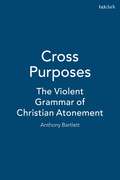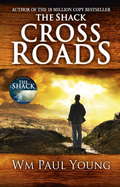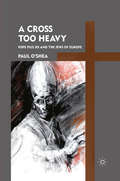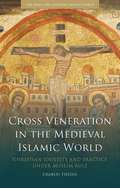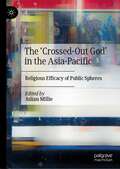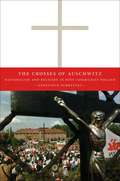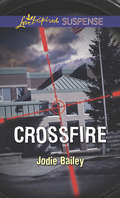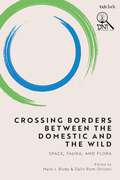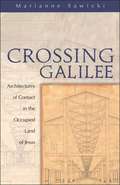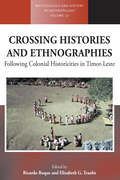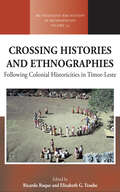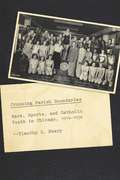- Table View
- List View
Cross Purposes: The Violent Grammar of Christian Atonement
by Anthony BartlettThis seminal study of the Christian theory of the atonement examines the story of Christian violence. In Cross Purposes, Anthony Bartlett claims that the key Western doctrines of atonement have been dominated by a logic of violence and sacrifice as a means of salvation. Subsequently, the graphic suffering of the crucified in images and narrative has served to unleash a prolonged sacrificial crisis in which there is always a potential need to displace blame. These doctrines of atonement have sanctioned wide-spread violence in the name of Christ throughout history. But Bartlett argues that a minority tradition also exists. He contends that the tradition of the compassion of Christ provides the possible way out of Christian violence. Bartlett's study gives this tradition a dynamic new reading, showing how it undoes both divine and human violence and offers a powerfully transformative version of atonement for the contemporary world. Cross Purposes provides a rich historical and theological overview of the evolution of various atonement theories, using literature, art, and philosophy to provide a creative and provocative reading of Christian atonement.Anthony Bartlett is engaged in post-doctoral research and is an instructor in Religion at Syracuse University.For: Seminarians; clergy; graduate students; professors
Cross Roads: What if you could go back and put things right?
by Wm Paul YoungMulti-millionaire Anthony Spencer is trapped in a coma and finds himself in a surreal world that reflects the skewed priorities of the life he's lived on earth where he meets a stranger who turns out to be Jesus and a grandmother who is the Holy Spirit.Pleading for a second chance, he is sent back to earth to redeem himself. There he must fight to put right the mess he's created, experiencing events through others' eyes before deciding how to use the miraculous gift he's been given. Before his illness he had set events in motion that he now needs to undo - but will he have the courage to make the right choice?THE SHACK is an international phenomenon, surpassing 1 million copies sold before being picked up by a mainstream publisher: its combination of radical spirituality with a heart-wrenching story made it a word-of-mouth hit, and CROSS ROADS has all the ingredients to repeat its impact.
Cross Roads Reflections: Inspiration for Every Day of the Year
by Wm. Paul YoungThe powerful story found in Cross Roads inspired and encouraged readers around the world. Now, CROSS ROADS REFLECTIONS provides an opportunity for you to revisit Tony and his redemption journey in a fresh and unique way.This 365-day devotional contains meaningful quotes from Cross Roads along with insightful and thought-provoking prayers written by the author, Wm. Paul Young, who also wrote the phenomenal bestseller, The Shack. It is designed to inspire, encourage, and uplift you every day of the year.
A Cross Too Heavy: Pope Pius XII and the Jews of Europe
by P. O'SheaThe papacy of Pius XII (1939-1958) has been a source of near-constant criticism and debate since his death, particularly because of his alleged silence during the Holocaust. Paul O'Shea examines his little-studied pre-papal life to demonstrate that Pius was neither an anti-Semitic villain nor a 'lamb without stain.'
Cross Veneration in the Medieval Islamic World: Christian Identity and Practice under Muslim Rule (Early and Medieval Islamic World)
by Charles TieszenOne of the most common religious practices among medieval Eastern Christian communities was their devotion to venerating crosses and crucifixes. Yet many of these communities existed in predominantly Islamic contexts, where the practice was subject to much criticism and often resulted in accusations of idolatry. How did Christians respond to these allegations? Why did they advocate the preservation of a practice that was often met with confusion or even contempt?
The ‘Crossed-Out God’ in the Asia-Pacific: Religious Efficacy of Public Spheres
by Julian MillieThis book explores the evaluations made by religious groups and individuals about the potential of public spheres for religious practice, focussing upon public religion in societies of the Asia-Pacific. Across this region we observe a resurgence of religious traditions, increasing mediatisation of religion, and an inward turn toward conservative political programs. Against this background, relations between religion and public domains are critical influences upon civic inclusion and equal citizenship.In contrast to conventional approaches to religion and public life that focus upon the public potential of religion, chapter authors focus upon the religious potential of public domains, taking the perspectives of religious actors as their points of departure. The book’s chapters capture the dynamic nexus between religion and politics in Asia-Pacific public spheres: why would Indonesia’s minority Shiite movement strive to develop a public profile in a national environment where it attracts widespread disapproval? What constructions of religion and public space make Banaras so unconducive to female mobility? Why does the success of the social services wing of Australia’s Salvation Army create anxiety for its religious wing? What is at stake for followers of Australian Spiritualism when they attend spirit-medium sessions? How are popular Islamic preachers vulnerable to action from Indonesia’s civil society organisations? What do media representations of Hajj pilgrimage by Indonesia’s presidents have in common with middle-class representations of gender? Why did Indonesia’s traditionalist Muslim intellectuals draw heavily upon the ideas of Jürgen Habermas in their theorisations of state-society relations?An epilogue by the Indonesian neo-traditionalist intellectual Ahmad Baso, the most prominent theorist of state-religion relations in that country, overviews the issues against the background of that country’s religious and political histories.
The Crosses of Auschwitz: Nationalism and Religion in Post-Communist Poland
by Geneviève ZubrzyckiIn the summer and fall of 1998, ultranationalist Polish Catholics erected hundreds of crosses outside Auschwitz, setting off a fierce debate that pitted Catholics and Jews against one another. While this controversy had ramifications that extended well beyond Poland’s borders, Geneviève Zubrzycki sees it as a particularly crucial moment in the development of post-Communist Poland’s statehood and its changing relationship to Catholicism. In The Crosses of Auschwitz, Zubrzycki skillfully demonstrates how this episode crystallized latent social conflicts regarding the significance of Catholicism in defining “Polishness” and the role of anti-Semitism in the construction of a new Polish identity. Since the fall of Communism, the binding that has held Polish identity and Catholicism together has begun to erode, creating unease among ultranationalists. Within their construction of Polish identity also exists pride in the Polish people’s long history of suffering. For the ultranationalists, then, the crosses at Auschwitz were not only symbols of their ethno-Catholic vision, but also an attempt to lay claim to what they perceived was a Jewish monopoly over martyrdom. This gripping account of the emotional and aesthetic aspects of the scene of the crosses at Auschwitz offers profound insights into what Polishness is today and what it may become.
The Crosses of Auschwitz: Nationalism and Religion in Post-Communist Poland
by Geneviève ZubrzyckiIn the summer and fall of 1998, ultranationalist Polish Catholics erected hundreds of crosses outside Auschwitz, setting off a fierce debate that pitted Catholics and Jews against one another. While this controversy had ramifications that extended well beyond Poland’s borders, Geneviève Zubrzycki sees it as a particularly crucial moment in the development of post-Communist Poland’s statehood and its changing relationship to Catholicism. In The Crosses of Auschwitz, Zubrzycki skillfully demonstrates how this episode crystallized latent social conflicts regarding the significance of Catholicism in defining “Polishness” and the role of anti-Semitism in the construction of a new Polish identity. Since the fall of Communism, the binding that has held Polish identity and Catholicism together has begun to erode, creating unease among ultranationalists. Within their construction of Polish identity also exists pride in the Polish people’s long history of suffering. For the ultranationalists, then, the crosses at Auschwitz were not only symbols of their ethno-Catholic vision, but also an attempt to lay claim to what they perceived was a Jewish monopoly over martyrdom. This gripping account of the emotional and aesthetic aspects of the scene of the crosses at Auschwitz offers profound insights into what Polishness is today and what it may become.
The Crosses of Auschwitz: Nationalism and Religion in Post-Communist Poland
by Geneviève ZubrzyckiIn the summer and fall of 1998, ultranationalist Polish Catholics erected hundreds of crosses outside Auschwitz, setting off a fierce debate that pitted Catholics and Jews against one another. While this controversy had ramifications that extended well beyond Poland’s borders, Geneviève Zubrzycki sees it as a particularly crucial moment in the development of post-Communist Poland’s statehood and its changing relationship to Catholicism. In The Crosses of Auschwitz, Zubrzycki skillfully demonstrates how this episode crystallized latent social conflicts regarding the significance of Catholicism in defining “Polishness” and the role of anti-Semitism in the construction of a new Polish identity. Since the fall of Communism, the binding that has held Polish identity and Catholicism together has begun to erode, creating unease among ultranationalists. Within their construction of Polish identity also exists pride in the Polish people’s long history of suffering. For the ultranationalists, then, the crosses at Auschwitz were not only symbols of their ethno-Catholic vision, but also an attempt to lay claim to what they perceived was a Jewish monopoly over martyrdom. This gripping account of the emotional and aesthetic aspects of the scene of the crosses at Auschwitz offers profound insights into what Polishness is today and what it may become.
The Crosses of Auschwitz: Nationalism and Religion in Post-Communist Poland
by Geneviève ZubrzyckiIn the summer and fall of 1998, ultranationalist Polish Catholics erected hundreds of crosses outside Auschwitz, setting off a fierce debate that pitted Catholics and Jews against one another. While this controversy had ramifications that extended well beyond Poland’s borders, Geneviève Zubrzycki sees it as a particularly crucial moment in the development of post-Communist Poland’s statehood and its changing relationship to Catholicism. In The Crosses of Auschwitz, Zubrzycki skillfully demonstrates how this episode crystallized latent social conflicts regarding the significance of Catholicism in defining “Polishness” and the role of anti-Semitism in the construction of a new Polish identity. Since the fall of Communism, the binding that has held Polish identity and Catholicism together has begun to erode, creating unease among ultranationalists. Within their construction of Polish identity also exists pride in the Polish people’s long history of suffering. For the ultranationalists, then, the crosses at Auschwitz were not only symbols of their ethno-Catholic vision, but also an attempt to lay claim to what they perceived was a Jewish monopoly over martyrdom. This gripping account of the emotional and aesthetic aspects of the scene of the crosses at Auschwitz offers profound insights into what Polishness is today and what it may become.
Crossfire: Safe By The Marshal's Side Frame-up Race For The Gold Crossfire (Mills And Boon Love Inspired Suspense Ser.)
by Jodie BaileyA DANGEROUS REUNION
The Crossing: My journey to the shattered heart of Syria
by Samar Yazbek Nashwa Gowanlock Ruth Ahmedzai Kemp'ONE OF THE FIRST POLITICAL CLASSICS OF THE 21st CENTURY'- Observer'EXTRAORDINARILY POWERFUL, POIGNANT AND AFFECTING. I WAS GREATLY MOVED' Michael PalinFOREWORD BY CHRISTINA LAMBJournalist Samar Yazbek was forced into exile by Assad's regime. When the uprising in Syria turned to bloodshed, she was determined to take action and secretly returned several times. The Crossing is her rare, powerful and courageous testament to what she found inside the borders of her homeland.From the first peaceful protests for democracy to the arrival of ISIS, she bears witness to those struggling to survive, to the humanity that can flower amidst annihilation, and why so many are now desperate to flee.
Crossing and Dwelling: A Theory of Religion
by Thomas A. TweedBeginning with a Cuban Catholic ritual in Miami, this book takes readers on a momentous theoretical journey toward a new understanding of religion. At this historical moment, when movement across boundaries is of critical importance for all areas of human life—from media and entertainment to economy and politics—Thomas Tweed offers a powerful vision of religion in motion, dynamic, alive with crossings and flows. A deeply researched, broadly gauged, and vividly written study of religion such as few American scholars have ever attempted, Crossing and Dwelling depicts religion in place and in movement, dwelling and crossing. Tweed considers how religion situates devotees in time and space, positioning them in the body, the home, the homeland, and the cosmos. He explores how the religious employ tropes, artifacts, rituals, and institutions to mark boundaries and to prescribe and proscribe different kinds of movements across those boundaries; and how religions enable and constrain terrestrial, corporeal, and cosmic crossings. Drawing on insights from the natural and social sciences, Tweed's work is grounded in the gritty particulars of distinctive religious practices, even as it moves toward ideas about cross-cultural patterns. At a time when scholars in many fields shy away from generalizations, this book offers a responsible way to think broadly about religion, a topic that is crucial for understanding the contemporary world. Lucid in explanations, engaging in presentation, rich in examples, Crossing and Dwelling has profound implications for the study and teaching of religion in our day.
Crossing Borders between the Domestic and the Wild: Space, Fauna, and Flora
by Mark J. Boda Dalit Rom-ShiloniThe present volume searches for different biblical perceptions of the wild, paying particular attention to the significance of fluid boundaries between the domestic and the wild, and to the options of crossing borders between them. Drawing on space, fauna, and flora, scholars investigate the ways biblical authors present the wild and the domestic and their interactions. In its six chapters and two responses, Hebrew Bible scholars, an archaeobotanist, an archaeologist, a geographer, and iconographers join forces to discuss the wild and its portrayals in biblical literature.The discussions bring to light the entire spectrum of real, imagined, metaphorized, and conceptualized forms of the wild that appear in biblical sources, as also in the material culture and agriculture of ancient Israel, and to some extent observe the great gap between biblical observations and modern studies of geography and of mapping that marks the distinctions between “the wilderness” and “the sown.” The book is the first written product presented on two consecutive years (2019, 2020) at the SBL Annual Meetings in the Section: “Nature Imagery and Conceptions of Nature in the Bible.”
Crossing Borders between the Domestic and the Wild: Space, Fauna, and Flora
by Mark J. Boda and Dalit Rom-ShiloniThe present volume searches for different biblical perceptions of the wild, paying particular attention to the significance of fluid boundaries between the domestic and the wild, and to the options of crossing borders between them. Drawing on space, fauna, and flora, scholars investigate the ways biblical authors present the wild and the domestic and their interactions. In its six chapters and two responses, Hebrew Bible scholars, an archaeobotanist, an archaeologist, a geographer, and iconographers join forces to discuss the wild and its portrayals in biblical literature.The discussions bring to light the entire spectrum of real, imagined, metaphorized, and conceptualized forms of the wild that appear in biblical sources, as also in the material culture and agriculture of ancient Israel, and to some extent observe the great gap between biblical observations and modern studies of geography and of mapping that marks the distinctions between “the wilderness” and “the sown.” The book is the first written product presented on two consecutive years (2019, 2020) at the SBL Annual Meetings in the Section: “Nature Imagery and Conceptions of Nature in the Bible.”
Crossing Confessional Boundaries: The Patronage of Italian Sacred Music in Seventeenth-Century Dresden
by Mary E. FrandsenThis book is an examination of the uneasy alliance of two confessions, Lutheran and Catholic, at the prominent seventeenth-century court of Dresden, and the implications of this alliance for the repertoire of sacred art music cultivated there, an influential repertoire that has received only scant attention from scholars.
Crossing Galilee: Architectures of Contact in the Occupied Land of Jesus
by Marianne SawickiRecent books about Jesus and early Christianity can be divided into two kinds: those that examine the life and work of the historical Jesus prior to his death and those that reconstruct events between Jesus' death and the writings of the first Gospels. Sawicki's provocative book challenges the results of both kinds of research by using both archaeology and anthropology to situate Jesus clearly in his Galilean cultural context.Sawicki contests recent portraits of Jesus as a Mediterranean peasant, a Cynic sage, or the convener of a fellowship of equals. In addition, she calls into question readings of ancient Galilee that emphasize it as a society marked simply by economic stratification or by an "honor-shame" sociology. Rather, she discovers the Galilean Jesus' indigenous cultural idiom in its material structures for the negotiation of kinship, the management of labor, the distribution of commodities, and the construction of gender.Sawicki's book is the first to balance classical urban archaeology against the more recent archaeology of villages and of local and regional commerce. It frames current issues in Jesus research in terms that can guide both ongoing village excavations in Israel and responsible exegesis of the Gospels in church and academy.Marianne Sawicki is the author of Seeing the Lord: Resurrection and Early Christian Practices.For: Seminarians; graduate students; biblical archaeologists
Crossing Histories and Ethnographies: Following Colonial Historicities in Timor-Leste (Methodology & History in Anthropology #37)
by Ricardo Roque and Elizabeth G. TraubeThe key question for many anthropologists and historians today is not whether to cross the boundary between their disciplines, but whether the idea of a disciplinary boundary should be sustained. Reinterpreting the dynamic interplay between archive and field, these essays propose a method for mutually productive crossings between historical and ethnographic research. It engages critically with the colonial pasts of indigenous societies and examines how fieldwork and archival studies together lead to fruitful insights into the making of different colonial historicities. Timor-Leste’s unusually long and in some ways unique colonial history is explored as a compelling case for these crossings.
Crossing Histories and Ethnographies: Following Colonial Historicities in Timor-Leste (Methodology & History in Anthropology #37)
by Ricardo Roque and Elizabeth G. TraubeThe key question for many anthropologists and historians today is not whether to cross the boundary between their disciplines, but whether the idea of a disciplinary boundary should be sustained. Reinterpreting the dynamic interplay between archive and field, these essays propose a method for mutually productive crossings between historical and ethnographic research. It engages critically with the colonial pasts of indigenous societies and examines how fieldwork and archival studies together lead to fruitful insights into the making of different colonial historicities. Timor-Leste’s unusually long and in some ways unique colonial history is explored as a compelling case for these crossings.
Crossing Histories and Ethnographies: Following Colonial Historicities in Timor-Leste (Methodology & History in Anthropology #37)
by Ricardo Roque Elizabeth G. TraubeThe key question for many anthropologists and historians today is not whether to cross the boundary between their disciplines, but whether the idea of a disciplinary boundary should be sustained. Reinterpreting the dynamic interplay between archive and field, these essays propose a method for mutually productive crossings between historical and ethnographic research. It engages critically with the colonial pasts of indigenous societies and examines how fieldwork and archival studies together lead to fruitful insights into the making of different colonial historicities. Timor-Leste’s unusually long and in some ways unique colonial history is explored as a compelling case for these crossings.
Crossing Histories and Ethnographies: Following Colonial Historicities in Timor-Leste (Methodology & History in Anthropology #37)
by Ricardo Roque Elizabeth G. TraubeThe key question for many anthropologists and historians today is not whether to cross the boundary between their disciplines, but whether the idea of a disciplinary boundary should be sustained. Reinterpreting the dynamic interplay between archive and field, these essays propose a method for mutually productive crossings between historical and ethnographic research. It engages critically with the colonial pasts of indigenous societies and examines how fieldwork and archival studies together lead to fruitful insights into the making of different colonial historicities. Timor-Leste’s unusually long and in some ways unique colonial history is explored as a compelling case for these crossings.
Crossing Parish Boundaries: Race, Sports, and Catholic Youth in Chicago, 1914-1954 (Historical Studies of Urban America)
by Timothy B. NearyControversy erupted in spring 2001 when Chicago’s mostly white Southside Catholic Conference youth sports league rejected the application of the predominantly black St. Sabina grade school. Fifty years after Brown v. Board of Education, interracialism seemed stubbornly unattainable, and the national spotlight once again turned to the history of racial conflict in Catholic parishes. It’s widely understood that midcentury, working class, white ethnic Catholics were among the most virulent racists, but, as Crossing Parish Boundaries shows, that’s not the whole story. In this book, Timothy B. Neary reveals the history of Bishop Bernard Sheil’s Catholic Youth Organization (CYO), which brought together thousands of young people of all races and religions from Chicago’s racially segregated neighborhoods to take part in sports and educational programming. Tens of thousands of boys and girls participated in basketball, track and field, and the most popular sport of all, boxing, which regularly filled Chicago Stadium with roaring crowds. The history of Bishop Sheil and the CYO shows a cosmopolitan version of American Catholicism, one that is usually overshadowed by accounts of white ethnic Catholics aggressively resisting the racial integration of their working-class neighborhoods. By telling the story of Catholic-sponsored interracial cooperation within Chicago, Crossing Parish Boundaries complicates our understanding of northern urban race relations in the mid-twentieth century.
Crossing Parish Boundaries: Race, Sports, and Catholic Youth in Chicago, 1914-1954 (Historical Studies of Urban America)
by Timothy B. NearyControversy erupted in spring 2001 when Chicago’s mostly white Southside Catholic Conference youth sports league rejected the application of the predominantly black St. Sabina grade school. Fifty years after Brown v. Board of Education, interracialism seemed stubbornly unattainable, and the national spotlight once again turned to the history of racial conflict in Catholic parishes. It’s widely understood that midcentury, working class, white ethnic Catholics were among the most virulent racists, but, as Crossing Parish Boundaries shows, that’s not the whole story. In this book, Timothy B. Neary reveals the history of Bishop Bernard Sheil’s Catholic Youth Organization (CYO), which brought together thousands of young people of all races and religions from Chicago’s racially segregated neighborhoods to take part in sports and educational programming. Tens of thousands of boys and girls participated in basketball, track and field, and the most popular sport of all, boxing, which regularly filled Chicago Stadium with roaring crowds. The history of Bishop Sheil and the CYO shows a cosmopolitan version of American Catholicism, one that is usually overshadowed by accounts of white ethnic Catholics aggressively resisting the racial integration of their working-class neighborhoods. By telling the story of Catholic-sponsored interracial cooperation within Chicago, Crossing Parish Boundaries complicates our understanding of northern urban race relations in the mid-twentieth century.
Crossing Parish Boundaries: Race, Sports, and Catholic Youth in Chicago, 1914-1954 (Historical Studies of Urban America)
by Timothy B. NearyControversy erupted in spring 2001 when Chicago’s mostly white Southside Catholic Conference youth sports league rejected the application of the predominantly black St. Sabina grade school. Fifty years after Brown v. Board of Education, interracialism seemed stubbornly unattainable, and the national spotlight once again turned to the history of racial conflict in Catholic parishes. It’s widely understood that midcentury, working class, white ethnic Catholics were among the most virulent racists, but, as Crossing Parish Boundaries shows, that’s not the whole story. In this book, Timothy B. Neary reveals the history of Bishop Bernard Sheil’s Catholic Youth Organization (CYO), which brought together thousands of young people of all races and religions from Chicago’s racially segregated neighborhoods to take part in sports and educational programming. Tens of thousands of boys and girls participated in basketball, track and field, and the most popular sport of all, boxing, which regularly filled Chicago Stadium with roaring crowds. The history of Bishop Sheil and the CYO shows a cosmopolitan version of American Catholicism, one that is usually overshadowed by accounts of white ethnic Catholics aggressively resisting the racial integration of their working-class neighborhoods. By telling the story of Catholic-sponsored interracial cooperation within Chicago, Crossing Parish Boundaries complicates our understanding of northern urban race relations in the mid-twentieth century.
Crossing Parish Boundaries: Race, Sports, and Catholic Youth in Chicago, 1914-1954 (Historical Studies of Urban America)
by Timothy B. NearyControversy erupted in spring 2001 when Chicago’s mostly white Southside Catholic Conference youth sports league rejected the application of the predominantly black St. Sabina grade school. Fifty years after Brown v. Board of Education, interracialism seemed stubbornly unattainable, and the national spotlight once again turned to the history of racial conflict in Catholic parishes. It’s widely understood that midcentury, working class, white ethnic Catholics were among the most virulent racists, but, as Crossing Parish Boundaries shows, that’s not the whole story. In this book, Timothy B. Neary reveals the history of Bishop Bernard Sheil’s Catholic Youth Organization (CYO), which brought together thousands of young people of all races and religions from Chicago’s racially segregated neighborhoods to take part in sports and educational programming. Tens of thousands of boys and girls participated in basketball, track and field, and the most popular sport of all, boxing, which regularly filled Chicago Stadium with roaring crowds. The history of Bishop Sheil and the CYO shows a cosmopolitan version of American Catholicism, one that is usually overshadowed by accounts of white ethnic Catholics aggressively resisting the racial integration of their working-class neighborhoods. By telling the story of Catholic-sponsored interracial cooperation within Chicago, Crossing Parish Boundaries complicates our understanding of northern urban race relations in the mid-twentieth century.
